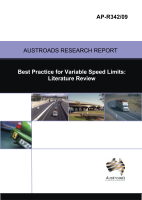Road Safety

Best Practice for Variable Speed Limits: Literature Review
- Publication no: AP-R342-09
- ISBN: 978-1-921551-70-3
- Published: 20 October 2009
- PDF (free) Download
This report aims to produce best practice recommendations as a basis for consistent application of variable speed limits in Australasia. VSL have been trialled since 1960s in the US and European countries. In Australasia, the first VSL trial started in 1993 and VSL projects are currently deployed in Sydney, Melbourne, Adelaide, the Northern Territory and Wellington. Experience in Australasia and the results of overseas research will be taken into account in formulating the best practice recommendations.
- Project Manager
- 1. INTRODUCTION
- 2. PROJECT SCOPE AND BACKGROUND
- 2.1. What is VSL?
- 2.2. Purposes of VSL installations
- 2.3. Scope of this Project
- Speed management and safety
- Managing speed for increasing demand and congestion
- Speed control for adverse weather
- Incident management
- School zone and entertainment speed area
- Tunnel and bridge speed management
- Roadwork speed zone
- 3. OVERVIEW OF INTERNATIONAL VSL INITIATIVES
- 3.1. United States
- 3.1.1. New Jersey
- 3.1.2. Washington State
- 3.1.3. Nevada
- 3.1.4. Arizona
- 3.1.5. New Mexico
- 3.2. Netherlands
- 3.3. United Kingdom
- 3.4. Germany
- 3.5. Finland
- 3.6. Sweden
- 3.7. Other countries
- The 1980s trial
- The 1992 trial
- The M25 project
- Vehicle-activated Signs
- M42 Project
- 4. OVERVIEW OF AUSTRALASIAN VSL PRACTICES
- 4.1. New South Wales
- 4.2. Victoria
- 4.3. Queensland
- 4.4. Western Australia
- 4.5. South Australia
- 4.6. Tasmania
- 4.7. Australia Capital Territory
- 4.8. Northern Territory
- 4.9. New Zealand
- M4 Motorway project
- F3 wet weather VSL project
- Blue Mountains fog system
- OH&S VSL project
- School zone electronic speed signs
- The Western Ring Road
- The Westgate Bridge
- Monash-CityLink-West Gate Upgrade
- School speed zones
- Shopping speed zones
- Behaviour study of Gateway upgrade project
- VSL application in school zones
- 5. SUMMARY OF KEY VSL OPERATIONAL ISSUES
- 5.1. Reported Results
- 5.1.1. Benefits
- 5.1.2. Impacts on Driver Behaviour
- 5.1.3. Economic Evaluation Results
- 5.2. System Components
- 5.2.1. Components of VSL systems
- 5.2.2. Examples of System Structure
- 5.3. Operational Principles
- 5.3.1. Speed Zone Requirement
- 5.3.2. Selection of Speed Limit
- 5.3.3. General Rules of Speed Changes
- 5.3.4. Failure Mode
- 5.3.5. Communicating and Highlighting Speed Changes
- 5.4. Signage Display and Placement
- 5.4.1. Type
- 5.4.2. Size
- 5.4.3. Location
- 5.4.4. Appearance and Signage Display
- 5.4.5. Sign Mounting and Protection
- 5.4.6. Vandal Resistance
- 5.5. Incorporation of Lane Control Signs (LCS)
- 5.6. Incorporation of Differential Speed Limits
- 5.7. Integration with Other ITS Devices
- 5.7.1. VMS
- 5.7.2. Ramp Metering
- 5.7.3. Integrated Traffic Management Systems
- 6. OTHER ISSUES
- 6.1. Enforcement and Legislation
- 6.2. Public Education
- 7. BEHAVIOUR STUDY PLAN
- 7.1. Issues Raised from the Literature Review
- 7.2. Summary of Previous Behaviour Studies
- 7.3. Scope of the Proposed Study
- 7.4. Proposed Method
- 7.5. Study Schedule
- 7.6. Other issues
- 7.6.1. Differential Speed Limits (DSL)
- 7.6.2. Sign Size
- 8. CONCLUSIONS AND RECOMMENDATIONS
- REFERENCES
Related publications
AP-R700-23
Latest Road Safety News
